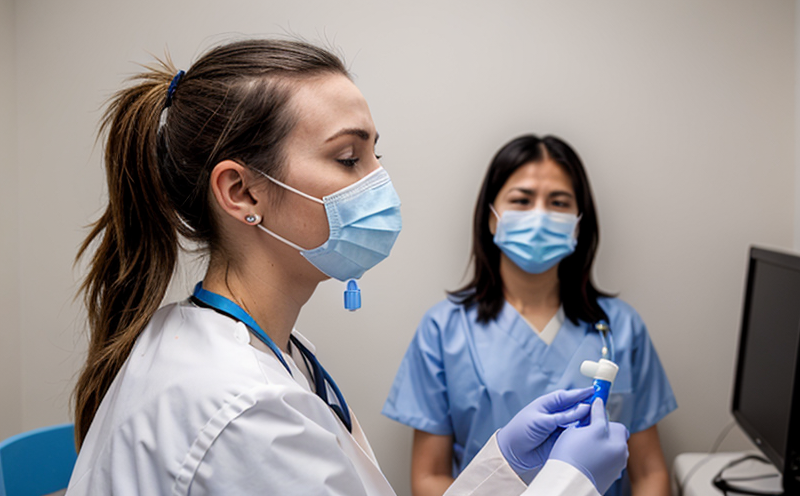Farm Dust Respiratory Hazard Testing
Respiratory diseases are a significant concern in agricultural settings, particularly among farm workers who handle large quantities of dust and other airborne contaminants. Farm dust can contain various allergens, endotoxins, and bioaerosols that pose respiratory hazards. Understanding these risks is critical for maintaining occupational health and ensuring compliance with regulatory standards.
The primary objective of farm dust respiratory hazard testing is to quantify the levels of potentially harmful particles in the air and assess their impact on respiratory health. This testing involves several key steps, including sample collection, laboratory analysis, and interpretation of results according to relevant international standards such as ISO 12944 and OSHA guidelines.
Sample preparation typically involves collecting dust samples using standardized methods like impingers or cyclone samplers. These samples are then analyzed for specific parameters, including total suspended particles (TSP), respirable particulate matter (PM2.5 and PM10), and bioaerosols such as mold spores and bacteria.
The testing process is stringent to ensure accurate results that can guide necessary interventions. Laboratories use advanced instrumentation such as scanning electron microscopy (SEM) for detailed particle morphology analysis, high-volume air samplers for collecting large volumes of air, and thermal desorption gas chromatography/mass spectrometry (GC/MS) for detecting trace organic compounds.
Once the data is collected, it undergoes rigorous quality control checks before being reported. The final report includes detailed information on particle size distribution, concentration levels, and any potential health risks associated with prolonged exposure to these substances. Compliance officers can use this information to implement effective dust control measures and protect worker health.
The importance of this testing cannot be overstated, especially given the increasing awareness of occupational health issues in agriculture. By identifying hazardous airborne contaminants early, employers can take proactive steps to reduce risks and maintain a safe working environment for all employees.
Benefits
The benefits of farm dust respiratory hazard testing extend beyond mere compliance; they offer substantial advantages in terms of worker health and safety. Regular monitoring helps identify potential hazards before they become severe, allowing for timely interventions that can prevent illnesses and reduce absenteeism.
- Improved Worker Health: By detecting harmful particles early, employers can implement targeted dust control strategies to minimize exposure.
- Enhanced Productivity: A healthy workforce is more productive; reducing respiratory issues translates directly into increased efficiency.
- Compliance with Regulations: Adhering to OSHA and other relevant standards ensures that businesses stay legally compliant, avoiding fines and penalties.
- Risk Reduction: Identifying and addressing hazards promptly reduces the overall risk profile of agricultural operations.
In summary, farm dust respiratory hazard testing is not just a compliance requirement but a proactive measure that supports sustainable business practices by fostering healthier work environments and enhancing operational effectiveness.
Why Choose This Test
Selecting the right laboratory for farm dust respiratory hazard testing is crucial to ensure accurate results and actionable insights. Our laboratory offers comprehensive services tailored specifically to the agricultural sector, providing expertise in sampling methodologies and analysis techniques that meet international standards.
We employ experienced scientists who have a deep understanding of both the unique challenges faced by farms and the best practices for addressing them. Our state-of-the-art facilities are equipped with advanced instrumentation capable of detecting even trace levels of harmful particles, ensuring precise measurements.
The reliability of our tests is further enhanced through strict quality control processes at every stage, from sample collection to final reporting. This ensures that clients receive accurate and trustworthy data upon which they can confidently base their decisions about workplace safety measures.
Moreover, our commitment to customer satisfaction means we offer flexible scheduling options and transparent communication throughout the testing process. Whether you are a quality manager looking for assurance or an R&D engineer seeking detailed insights into particle behavior, we provide tailored solutions designed specifically for your needs.
Use Cases and Application Examples
| Use Case | Description |
|---|---|
| Dust Control Strategy Development | Identify specific types of dust present in the air to develop targeted control strategies. |
| Air Quality Monitoring | Continuously monitor air quality over time to assess effectiveness of implemented measures. |
| New Product Testing | Evaluate newly introduced agricultural practices or equipment for potential respiratory hazards. |
- Disease Risk Assessment: Assess the risk of developing respiratory diseases among workers exposed to specific types of dust.
- Training Programs: Use test results to design and implement training programs on proper handling techniques for minimizing exposure.
- Policy Development: Inform policies aimed at improving workplace safety by providing evidence-based recommendations.
These use cases demonstrate how farm dust respiratory hazard testing plays a vital role in safeguarding the health of agricultural workers while also supporting broader business goals related to productivity and compliance.





